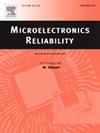Thermal ageing monitoring in CuAl intermetallic joints through electrical resistance drift: Comparative study of lifetime potential in pure and alloyed copper wires
IF 1.6
4区 工程技术
Q3 ENGINEERING, ELECTRICAL & ELECTRONIC
引用次数: 0
Abstract
Copper has pervasively replaced gold as preferred wire bonding material in Integrated Circuits (IC) plastic packaging. Different types of wires are available today in the market, with specific annealing treatments, coating and doping solutions aimed at optimizing bondability and reliability performances of the joints. In this study, the electrical resistance drift of packaged daisy chains has been analyzed to compare the lifetime potential of pure and alloyed copper wires under accelerated High Temperature Storage (HTS). Two aluminum-based bond-pads with different composition and thickness have been included in the experimental matrix. The results obtained through this statistically efficient and non-destructive methodology have been correlated with more “classical” readout data based on wire pull test, polished cross sections for Inter-Metallic Compounds (IMC) thickness measurement and TEM lamellas for phases stoichiometry characterization. Comparative analysis of the drift plots has pointed out a specific electrical signature for the consumption of the aluminum source under the IMC joint, confirmed by a Finite Element Method (FEM) simulation. A systematic delay in the IMC evolution has been demonstrated in all the samples with alloyed copper wires, correlating their lower ohmic drift with a lower thickness and a different composition of the IMC phases growing during HTS.
通过电阻漂移监测CuAl金属间接头的热老化:纯铜线和合金铜线寿命电位的比较研究
在集成电路(IC)塑料封装中,铜已普遍取代金成为首选的电线粘合材料。目前市场上有不同类型的电线,采用特定的退火处理、涂层和掺杂解决方案,旨在优化接头的粘合性和可靠性性能。本研究分析了包装雏菊链的电阻漂移,比较了纯铜线和合金铜线在加速高温储存(HTS)下的寿命电位。在实验基体中加入了两种不同成分和厚度的铝基粘结垫。通过这种统计上高效且无损的方法获得的结果与基于拉丝测试、金属间化合物(IMC)厚度测量的抛光截面和相化学计量学表征的TEM薄片的更“经典”读出数据相关联。通过对漂移图的对比分析,指出了IMC接头下铝源消耗的特定电特征,并通过有限元仿真得到了验证。所有合金铜线样品的IMC演化都有系统的延迟,其较低的欧姆漂移与较低的厚度和不同组成的IMC相在高温超导过程中生长有关。
本文章由计算机程序翻译,如有差异,请以英文原文为准。
求助全文
约1分钟内获得全文
求助全文
来源期刊

Microelectronics Reliability
工程技术-工程:电子与电气
CiteScore
3.30
自引率
12.50%
发文量
342
审稿时长
68 days
期刊介绍:
Microelectronics Reliability, is dedicated to disseminating the latest research results and related information on the reliability of microelectronic devices, circuits and systems, from materials, process and manufacturing, to design, testing and operation. The coverage of the journal includes the following topics: measurement, understanding and analysis; evaluation and prediction; modelling and simulation; methodologies and mitigation. Papers which combine reliability with other important areas of microelectronics engineering, such as design, fabrication, integration, testing, and field operation will also be welcome, and practical papers reporting case studies in the field and specific application domains are particularly encouraged.
Most accepted papers will be published as Research Papers, describing significant advances and completed work. Papers reviewing important developing topics of general interest may be accepted for publication as Review Papers. Urgent communications of a more preliminary nature and short reports on completed practical work of current interest may be considered for publication as Research Notes. All contributions are subject to peer review by leading experts in the field.
 求助内容:
求助内容: 应助结果提醒方式:
应助结果提醒方式:


